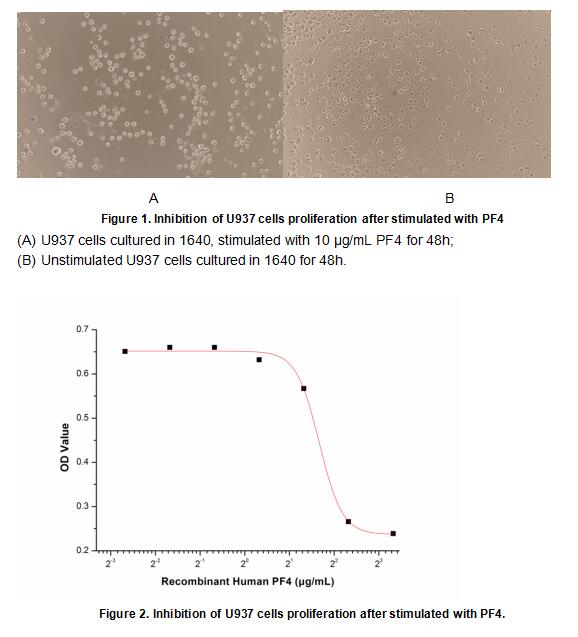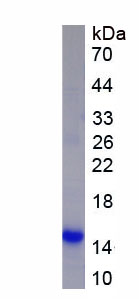Active Platelet Factor 4 (PF4)
CXCL4; SCYB4; Chemokine C-X-C-Motif Ligand 4; Oncostatin-A; Iroplact
- Product No.APA172Hu01
- Organism SpeciesHomo sapiens (Human) Same name, Different species.
- Buffer Formulation20mM Tris, 150mM NaCl, pH8.0, containing 1mM EDTA, 1mM DTT, 0.01% SKL, 5% Trehalose and Proclin300.
- Traits Freeze-dried powder
- Purity> 97%
- Isoelectric Point6.5
- ApplicationsCell culture; Activity Assays.
- DownloadInstruction Manual
- UOM 10µg50µg 200µg 1mg 5mg
- FOB
US$ 211
US$ 528
US$ 1056
US$ 3168
US$ 7920
For more details, please contact local distributors!
ACTIVITY TEST

Platelet factor 4 (PF4) is a small cytokine belonging to the CXC chemokine family that is also known as chemokine (C-X-C motif) ligand 4 (CXCL4). This chemokine is released from alpha-granules of activated platelets during platelet aggregation, and promotes blood coagulation by moderating the effects of heparin-like molecules. Due to these roles, it is predicted to play a role in wound repair and inflammation. It was reported that PF4 can inhibits U937 cells proliferation. To test the effect of U937 on cell apoptosis, U937 cells were seeded into 96-well plates at a density of 5,000 cells/well with 5% serum standard 1640 including various concentrations of recombinant Human PF4. After incubated for 48 h, cells were observed by inverted microscope and cell proliferation was measured by Cell Counting Kit-8 (CCK-8). Briefly, 10 µL of CCK-8 solution was added to each well of the plate, then the absorbance at 450 nm was measured using a microplate reader after incubating the plate for 4 hours at 37℃. Proliferation of U937 cells after incubation with PF4 for 48 h observed by inverted microscope was shown in Figure 1. Cell viability was assessed by CCK-8 assay after incubation with recombinant Human PF4 for 48 h. The result was shown in Figure 2. It was obvious that PF4 significantly inhibit cell viability of U937 cells. The ED50 is 2.2-3.1μg/mL.
USAGE
Reconstitute in 20mM Tris, 150mM NaCl (PH8.0) to a concentration of 0.1-1.0 mg/mL. Do not vortex.
STORAGE
Avoid repeated freeze/thaw cycles. Store at 2-8°C for one month. Aliquot and store at -80°C for 12 months.
STABILITY
The thermal stability is described by the loss rate. The loss rate was determined by accelerated thermal degradation test, that is, incubate the protein at 37°C for 48h, and no obvious degradation and precipitation were observed. The loss rate is less than 5% within the expiration date under appropriate storage condition.
GIVEAWAYS
INCREMENT SERVICES
-
 BCA Protein Quantification Kit
BCA Protein Quantification Kit
-
 Molecular Mass Marker for Protein
Molecular Mass Marker for Protein
-
 Monoclonal Antibody Customized Service
Monoclonal Antibody Customized Service
-
 Polyclonal Antibody Customized Service
Polyclonal Antibody Customized Service
-
 Protein Activity Test Experiment Service
Protein Activity Test Experiment Service
-
 Electrophoretic Mobility Shift Assay (EMSA) Experiment Service
Electrophoretic Mobility Shift Assay (EMSA) Experiment Service
-
 Buffer
Buffer
-
 Lentivirus Packaging Experiment Service
Lentivirus Packaging Experiment Service
-
 Adenovirus Packaging Experiment Service
Adenovirus Packaging Experiment Service
-
 Real Time PCR Experimental Service
Real Time PCR Experimental Service
-
 Spike RBD Protein (S-RBD)
Spike RBD Protein (S-RBD)
-
 Protein G
Protein G
-
 Protein A
Protein A
| Magazine | Citations |
| Biochimica et Biophysica Acta (BBA) - Proteins & Proteomics | Propofol lowers serum PF4 level and partially corrects hypercoagulopathy in endotoxemic rats PubMed: 20601223 |
| Basic Research in Cardiology | Secretome of apoptotic peripheral blood cells (APOSEC) attenuates microvascular obstruction in a porcine closed chest reperfused acute myocardial infarction model: role of platelet aggregation and vasodilation PubMed: 22899170 |
| PLoS One | Platelets Recognize Brain-Specific Glycolipid Structures, Respond to Neurovascular Damage and Promote Neuroinflammation PubMed: PMC3608633 |
| Diving and Hyperbaric Medicine | Effect of splenectomy on platelet activation and decompression sickness outcome in a rat model of decompression Pubmed:25311322 |
| Journal of Functional Foods | A Phellinus baumii–based supplement containing Salvia miltiorrhiza Bunge improves atherothrombotic profiles through endothelial nitric oxide synthase and cyclooxygenase pathwaysin vitro and in vivo science:S1756464616300676 |
| Plos one | Aspirin, but Not Tirofiban Displays Protective Effects in Endotoxin Induced Lung Injury pubmed:27583400 |
| international journal of molecular sciences | Evidence of the Role of R-Spondin 1 and Its Receptor Lgr4 in the Transmission of Mechanical Stimuli to Biological Signals for Bone Formation. pubmed:28272338 |
| Experimental and Therapeutic Medicine | Feasibility of improving platelet‑rich plasma therapy by using chitosan with high platelet activation ability pubmed:28450960 |
| Reproductive Toxicology | Aspirin pre-treatment modulates ozone-induced fetal growth restriction and alterations in uterine blood flow in rats Pubmed: 30528429 |
| INTERNATIONAL JOURNAL OF CARDIOLOGY | Short and long-term changes in platelet and inflammatory biomarkers after cryoballoon and radiofrequency ablation Pubmed: 30857843 |
| Available at SSRN 3335365 | Evaluating the Platelet Activation Related to the Degradation of Biomaterials by Scheme of Molecular Markers |
| journal of biotechnology | Newly Identified HNP‐F from Human Neutrophil Peptide 1 Promotes Hemostasis Pubmed: 30927490 |
| Data in Brief | Data for short and long-term prothrombotic biomarkers after cryoballoon and radiofrequency ablation |
| journal of thoracic and cardiovascular surgery | Evaluating Platelet Activation Related to the Degradation of Biomaterials Using Molecular Markers Pubmed: 32812629 |
| Marine Drugs | The Inhibitory Effect of Protamine on Platelets is Attenuated by Heparin without Inducing Thrombocytopenia in Rodents Pubmed: 31533230 |
| Thrombosis Research | Feasibility study of use of rabbit blood to evaluate platelet activation by medical devices Pubmed: 31838449 |
| Nat Commun | The C5a/C5a receptor 1 axis controls tissue neovascularization through CXCL4 release from platelets 34099640 |
| Vaccine | The effect of ChAdOx1 nCov-19 vaccine on arterial thrombosis development and platelet aggregation in female rats Pubmed:35183388 |
| Catalog No. | Related products for research use of Homo sapiens (Human) Organism species | Applications (RESEARCH USE ONLY!) |
| APA172Hu01 | Active Platelet Factor 4 (PF4) | Cell culture; Activity Assays. |
| RPA172Hu01 | Recombinant Platelet Factor 4 (PF4) | Positive Control; Immunogen; SDS-PAGE; WB. |
| RPA172Hu02 | Recombinant Platelet Factor 4 (PF4) | Positive Control; Immunogen; SDS-PAGE; WB. |
| PAA172Hu01 | Polyclonal Antibody to Platelet Factor 4 (PF4) | WB; IHC; ICC; IP. |
| PAA172Hu02 | Polyclonal Antibody to Platelet Factor 4 (PF4) | WB; IHC; ICC; IP. |
| LAA172Hu71 | Biotin-Linked Polyclonal Antibody to Platelet Factor 4 (PF4) | WB; IHC; ICC. |
| LAA172Hu81 | FITC-Linked Polyclonal Antibody to Platelet Factor 4 (PF4) | WB; IHC; ICC; IF. |
| MAA172Hu21 | Monoclonal Antibody to Platelet Factor 4 (PF4) | WB; IHC; ICC; IP. |
| MAA172Hu23 | Monoclonal Antibody to Platelet Factor 4 (PF4) | WB; IHC; ICC; IP. |
| MAA172Hu24 | Monoclonal Antibody to Platelet Factor 4 (PF4) | WB; IHC; ICC; IP. |
| MAA172Hu22 | Monoclonal Antibody to Platelet Factor 4 (PF4) | WB; IHC |
| MAA172Hu25 | Monoclonal Antibody to Platelet Factor 4 (PF4) | WB; IHC; ICC; IP. |
| SEA172Hu | ELISA Kit for Platelet Factor 4 (PF4) | Enzyme-linked immunosorbent assay for Antigen Detection. |
| AEA172Hu | ELISA Kit for Anti-Platelet Factor 4 Antibody (Anti-PF4) | Enzyme-linked immunosorbent assay for Antibody Detection. |
| SCA172Hu | CLIA Kit for Platelet Factor 4 (PF4) | Chemiluminescent immunoassay for Antigen Detection. |
| LMA172Hu | Multiplex Assay Kit for Platelet Factor 4 (PF4) ,etc. by FLIA (Flow Luminescence Immunoassay) | FLIA Kit for Antigen Detection. |
| PSA172Hu01 | Antibody Pair for Platelet Factor 4 (PF4) | ELISA; CLIA; ELISPOT; Luminex; Immunochromatography and other Immunoassays. |
| KSA172Hu01 | ELISA Kit DIY Materials for Platelet Factor 4 (PF4) | Main materials for "Do It (ELISA Kit) Yourself". |








